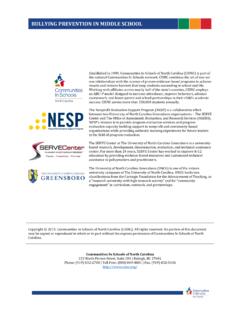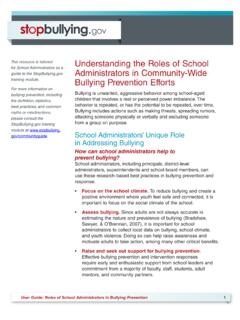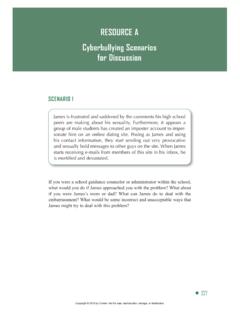Transcription of Bullying Prevention Lesson PLAN (Grades 6-8)
1 Dear Educator,October is National Bullying Prevention Month. Please find attached an engaging and helpful Lesson plan for use with your students to help prevent and stop Lesson is provided by the Monique Burr Foundation for Children (MBF). It was created by educators and Prevention specialists at MBF and is based on the 5 Safety Rules from our Prevention education program, MBF Teen Safety Matters . Our Prevention education programs are comprehensive, research-based, and have reached nearly 2 million students since 2010. MBF Teen Safety Matters is taught to sixth through eighth grade students, while MBF Child Safety Matters is taught to kindergarten through fifth grade students.
2 The programs are typically taught by the school counselor, and are provided at no cost to Florida public schools. The concepts taught in this Lesson provide your students with proven tools to address Bullying and cyberbullying. Both victims and bullies suffer from a variety of negative consequences including isolation, depression, anxiety, lower academic achievement, substance use, and the potential for suicide. But Bullying is preventable. We can teach empathy, kindness, and Bullying Prevention strategies through lessons such as this one. Bolded and underlined words in the script are key terms that students need to understand. The definitions of these terms are explained throughout the Lesson .
3 Please reiterate their meaning throughout the Lesson to ensure comprehension. Help prevent Bullying by completing this brief, fun, and educational Lesson with your students, and by encouraging your school to adopt and consistently use the MBF Teen Safety Matters program. Contact us at for more information. Also, please make note of our October Social Media Campaign, we d love for your class and/or school to participate. October Social Media Campaign: The Monique Burr Foundation for Children is doing a Bullying Prevention Social Media Campaign (Facebook, Instagram, and Twitter) throughout the month of October called #kindvibes. There are several ways to Have students (individually, in groups, or as a class) create a short post about why kindness matters or what they are doing to spread kind vibes.
4 Post it to social media using #kindvibes and # Post a picture of all students (with permission) holding their worksheets along with #kindvibes and # Post a picture of students worksheets hanging in classroom along with #kindvibes and # Any other ideas you can think of related to kindness. Make sure you include #kindvibes and # Prevention Lesson plan (Grades 6-8) Bullying Prevention Lesson plan (Grades 6-8) Grade Level6 - 8 Lesson Length45 MinutesLesson Objectives Understand Bullying and cyberbullying Introduce the MBF Teen Safety Matters Safety Rules Understand how to be an Upstander and how to report Bullying Understand the connection between empathy and Bullying preventionMaterials Lesson plan /Instructions Optional activity worksheetKey Terms Assertive Voice Bully Bystander Cyberbullying Empathy Imbalance of power Purpose Repeated Safe Adult Safe Friend UpstanderRelated Common Core Standards and NationalHealth Education Standards 6th Grade 8.
5 8 .1 7. 8 . 27. 8 . 3 Grade S L . L . L . 7. 2 L . 7. 2 . B L . 7. 3 L . 7. 6 1. 1. 8. 5 4. 5. 8 .1 7. 8 . 27. 8 . 3 Grade SL. L. 1. 1. 8. 5 4. 5. 8 .1 7. 8 . 27. 8 . 3 Prevention Lesson plan (Grades 6-8) Additional Resources (For Teachers and Parents)MBF Child Safety Matters: Child Safety Matters App: Free download from the App Store or Google PlayNEA Bullying Prevention Kit: BullyBust: The Bully Project (with Educator Toolkit): PACER National Bullying Prevention Site: The Institute for Responsible Online Citizenship: National Center for Missing & Exploited Children: Wired Kids Internet Safety Site: 1 Good morning/afternoon students.
6 I want to spend some time today talking about an important topic. October is National Bullying Prevention Month. By now, you all know that Bullying is wrong; we want to educate you on how to prevent it. What happens at our school if Bullying were to occur? (Elicit responses from students. Explain the protocol taken by your school in the event of Bullying .) Many times, when people think of Bullying , they think of fighting, arguing, or mean and rude behavior. These are not appropriate behaviors, but they may not be Bullying . An easy way to remember what Bullying means is by using the acronym RIP: (Write RIP on the board): Repeated This means it happens over and over again, NOT just one time.
7 Imbalance of Power This means someone who is bigger, stronger, and/or more popular than another person is using the imbalance of power to bully. It can include telling them to do something and even if the person does not want to do it, they do not have the courage or confidence to say no. On Purpose This means it happens on purpose. It does not happen by mistake, but instead it is done intentionally. Bullying occurs face-to-face, while cyberbullying occurs through electronic devices like computers or cell phones. How could cyberbullying happen? (Elicit responses such as texting, posts on social media, online gaming chats, etc.) Some of you may have experienced Bullying or cyberbullying, or have seen it happening.
8 Neither form of Bullying is ever safe; I want to help you know what to do if you see it and how to stay safe. Today we are going to learn about the MBF Teen Safety Matters Safety Rules and other traits and behaviors to help us prevent and respond to Bullying . Write each rule on the board as you introduce it. Safety Rule #1 is Know What s Up. This means you are aware of what Bullying is in your environment and who you are talking to, online and offline. It is knowing what websites are appropriate or inappropriate. This also means that you are aware of the social interactions that are occurring around you, and you know what Bullying behaviors look like. Raise your hand to tell us some behaviors of a bully.
9 (Elicit responses) Safety Rule #2 is Spot Red Flags. Think of a traffic light. When you see a traffic light that is red, what does the driver do? (Elicit responses) STUDENT DISCUSSIONPAGE 2 Spot Red Flags means you STOP and use your awareness to determine if someone s behavior or social interaction online or offline is Bullying or unsafe. This could be someone trying to control someone else, or saying hurtful things to them on purpose. What are some Red Flags you should be aware of? (Allow students to offer suggestions, then follow up with these suggestions if they are not offered by students): A student or group of students picking on someone else. A student who doesn t have any friends.
10 A student who sits alone. A student who never has a partner. A student who is always made fun of. Texting or typing on social media about someone in a hurtful way. If you see Red Flags, you can then use the other Safety Rules you will learn today to avoid those Bullying behaviors and dangers. Safety Rule #3 is Make a Move. This rule involves making a good decision when you see a Red Flag and getting away from an unsafe situation, or staying away from those who are making a poor decision. Bullying behaviors are Red Flags. If you see Bullying occur, you can choose to get away and stay away from the situation, and spend your time with people who are going to make good, safe decisions.








